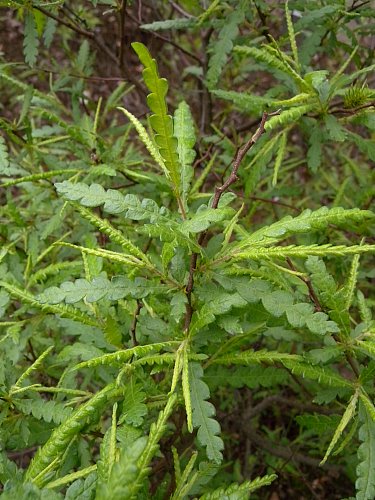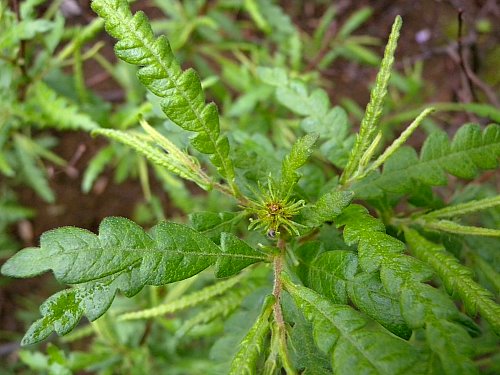
Sweet Fern can be dioecious or monoecious with unisexual florets that are arranged in greenish catkins toward the tips of twigs or young shoots. The male catkins are ¾-1½" long and cylindrical in shape, consisting of numerous male florets and their overlapping scales. Each male floret has 4-8 stamens on short filaments; it is partially hidden by a small scale (about 2-3 mm. in length) that is broadly ovate and ciliate along its margins. The female catkins are about ½" long and ovoid to globoid in shape, consisting of a small cluster of female florets and their scales. Each female floret has a naked ovary with a pair of stigmata at its apex; it is partially hidden by a small scale (about 2-3 mm. in length) that is broadly ovate and ciliate along its margins. In addition to this scale, there is a pair of linear bractlets that originate from the base of the ovary; they are up to twice the length of the scale. The blooming period occurs from mid- to late spring as the vernal leaves begin to develop, lasting about 2 weeks. Afterwards, the female catkins are replaced by bristly fruits that span about ¾" across; each fruit contains a cluster of nutlets at its center and numerous bristly bractlets. At maturity, individual nutlets are 3-5 mm. long, ovoid in shape, truncate-dentate on one side, and rounded on the other. The
Cultivation: The preference is full or partial sun, mesic to dry conditions, and sandy soil. The root system of Sweet Fern can fix nitrogen in the soil. This shrub is an alternate host of a blister rust that infects Jack Pine (Pinus banksiana).
Range & Habitat: The native Sweet Fern (Comptonia peregrina) is rare in Illinois, where it is largely restricted to the NE section of the state. It is state-listed as 'endangered.' Habitats include upland sand prairies, sandy shrub prairies, and sandy upland savannas. Dominant trees in these savannas are oak trees (especially Black Oak) and sometimes pine trees are present (especially Jack Pine). Sweet Fern benefits from occasional wildfires as this reduces competition from taller shrubs and trees. The seeds can lie dormant in the soil for several decades while waiting for such wildfires to occur.
Faunal Associations: Various insects feed on the foliage and other parts of Sweet Fern (Comptonia peregrina). These species include leaf beetles, a monophagous leaf-rolling weevil, larvae of a gall fly, aphids, a spittlebug, a leafhopper, and larvae of several moths; see the Insect Table for a more complete list of these species. Some vertebrate animals also use Sweet Fern as a source of food. The Ruffed Grouse feeds on the buds and catkins, while the White-tailed Deer browses on the twigs and foliage. Two bird species, the Mourning Dove and Northern Flicker, have been observed to feed on the nutlets of this small shrub (DeGraaf, 2002; Martin et al., 1951/1961). The nests of a Federally endangered bird, Kirtland's Warbler (Setophaga kirtlandii), are often located near colonies of Sweetfern at the base of Jack Pines (Pinus banksiana). Such colonies provide protective cover for many kinds of wildlife.

Photographic Location: A garden at the Kitty Todd Nature Preserve in NW Ohio.
Comments: This shrub belongs to a monotypic genus that is endemic to North America. It is related to the Bayberry shrubs (Myrica spp.) that are found on sandy coastlines along the Atlantic Ocean and Gulf of Mexico. Unlike Sweet Fern, Bayberry shrubs produce waxy fruits. In spite of its common name and the appearance of its attractive leaves, Sweet Fern is not related to the true ferns. Perhaps its most notable characteristic is the pleasant fragrance of its crushed leaves and twigs.